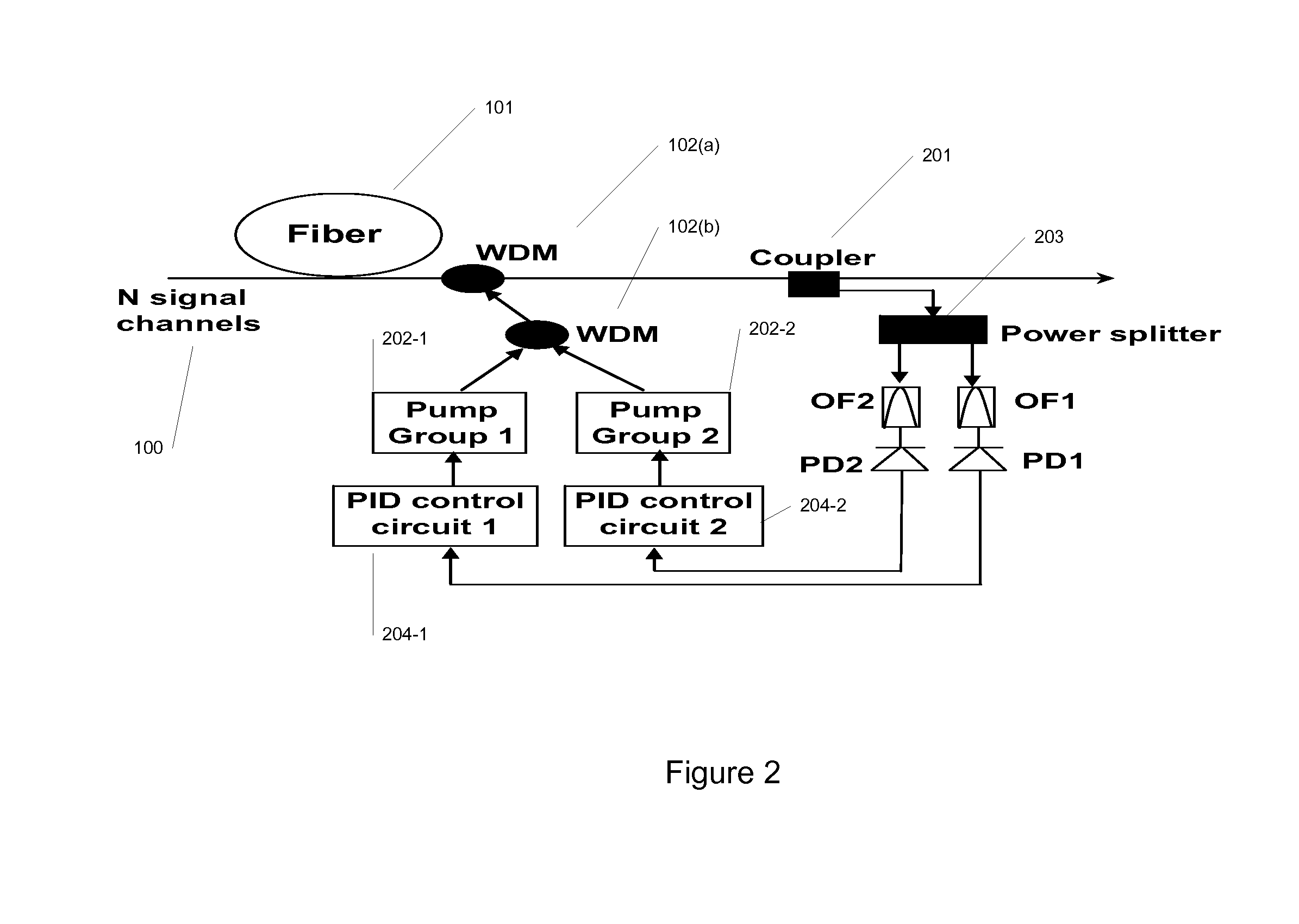Improved feedback dynamic gain control for a WDM system employing multi wavelength pumped raman fiber amplifiers
- Summary
- Abstract
- Description
- Claims
- Application Information
AI Technical Summary
Benefits of technology
Problems solved by technology
Method used
Image
Examples
first embodiment
[0021] Referring now to FIG. 3, there is shown the present invention, where the output power at one single wavelength is used as the feedback signal to control the M Raman pumps 103 in a backward-pumped RFA. As an illustration, here, a PID algorithm is used as the control algorithm; (another algorithm such as proportional algorithm may also be used as the feedback control algorithm). For convenience, we assume that the time dependent output power at the shortest-wavelength signal, SL(1,t), is monitored and used as the feedback signal. Then the dynamic control equation for pump j in accordance with the linear equation of EQ. 1 / EQ. 3 is given by PL(j,t+dt)≈PL(j,t)+CLL(j)CLL(1)[D0(SL(1,t)-SL 0(1))+D1ⅆⅆt(SL(1,t)-SL 0(1))]EQ. 5
and the dynamic control equation in accordance with the linear equation of EQ. 2 / EQ. 4 is given by Pd(j,t+dt)≈Pd(j,t)+Cd L(j)Cd L(1)[D0(SL(1,t)-SL 0(1))+D1ⅆⅆt(SL(1,t)-SL 0(1))]EQ. 6
where SL0(1) denotes the target output pow...
third embodiment
[0025] FIGS. 6 (a) and (b) illustrate the present invention. FIGS. 6(a) and 6(b) differ in the use by FIG. 6(b), not shown in FIG. 6(a), of an optical supervisory channel and first and second control circuits 603-1 and 603-2 for providing gain and feed-forward signals Sin. Both the total input signal power Sin and the total output signal power Sout are monitored in the embodiments of FIGS. 6(a) and 6(b). The total input signal power Sin is used as the feed-forward signal for the feed-forward control circuit 601, and the total gain (defined as Sout / Sin) is used as the feedback signal for the feed-back control circuit 602. For the feed-forward control circuit 601, EQ. 1 or EQ. 2 may be used as the control equation. For the feed-back control circuit 602, EQ. 5 or EQ. 6 may be used as the control equation (replacing the output signal power with the total gain). For a backward-pumped discrete RFA, both Sin and Sout may be monitored right before / after the RFA as is shown in FIGS. 6 (a) an...
PUM
 Login to View More
Login to View More Abstract
Description
Claims
Application Information
 Login to View More
Login to View More - R&D
- Intellectual Property
- Life Sciences
- Materials
- Tech Scout
- Unparalleled Data Quality
- Higher Quality Content
- 60% Fewer Hallucinations
Browse by: Latest US Patents, China's latest patents, Technical Efficacy Thesaurus, Application Domain, Technology Topic, Popular Technical Reports.
© 2025 PatSnap. All rights reserved.Legal|Privacy policy|Modern Slavery Act Transparency Statement|Sitemap|About US| Contact US: help@patsnap.com



